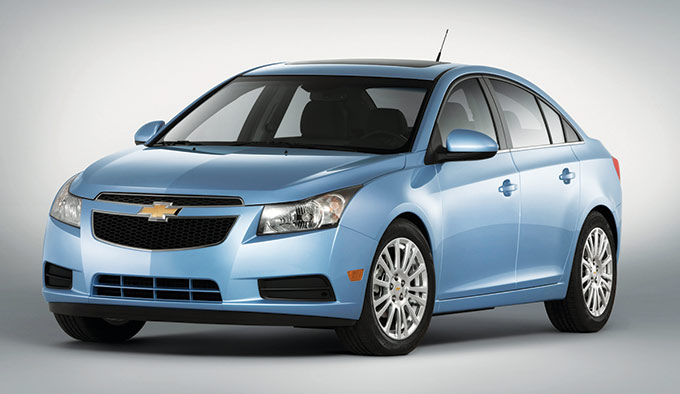It's Big Nuze
by Jim Corbran

The 2011 Chevy Cruze
Although it seems we’ve been getting beaten over the head for the past three years or so with news of Chevy’s electric car, the Volt, the car that may be bigger news (for General Motors, anyway) is the compact Chevy Cruze. Introduced for the 2011 model year to replace the well-worn Cobalt (previously known as Cavalier), the Cruze is GM’s latest entry into the market which hopes to put a dent (a big dent) in sales of Toyota Corollas and Honda Civics. At least, that was the plan at the onset. Now, equal competition exists in the much-improved South Korean Hyundai Elantra, and the equally-as-good Kia Forte. GM has its work cut out for it. Add to the mix the all-new Ford Focus, which is just around the bend, and it makes for an interesting competition.
This time around, Chevy should do just fine. The Cruze is far from the boring old Cobalt. It looks better, quality seems higher, and it’s packed with features which should appeal to any buyer in the segment—no matter if they’re trading in a Corolla, Cobalt, or Focus. The first thing that struck me as I approached this week’s test car at Paddock Chevrolet in Kenmore was how much better it looked than the Cobalt. Especially in black. (Of course, it was still clean.) While not groundbreaking, the styling is clean and free of gimmicks—no ersatz fender “portholes,” no out-of-place chrome doo-dads, no trick window dips. Just a crisp look, from the now familiar Chevy front grille design, through some nice side sculpting, and on to a simple but effective rear bumper and taillight grouping. I think it works well and is proportioned correctly for this size car.
The interior is also head and shoulders above the Cobalt, and should hold its own with the imports. The test car was a 2LT model, which puts it near the top of the Cruze heap (for now), just below the LTZ, with heated leather seats, tilt and telescoping leather wheel, and steering wheel controls for the audio system and the cruise (cruze?) control. And of course, in this day and age, in which no American, by law, is allowed out of the house without drink in hand, there are cup holders. I found it interesting that in its press material, Chevy describes them thusly: “Two in front center console, two in rear seat armrest and one bottle holder in each front door panel.” So, now we’ve moved on to bottle holders. In the next few years perhaps we’ll see a spigot built into the dash.
Climbing into the Cruze was no problem. And once in, salesman Chris Call and I, a couple of tall guys, had plenty of head and leg room. The rear seat is also roomy, although with a couple of tall guys in the front, leg room back there is pretty iffy. The rear seat folds 60/40 to enlarge cargo-carrying capacity, and there are floor-mounted heat ducts to keep rear passengers warm this time of year.
But how does it drive, you ask. American compacts over the years have been notoriously dull in the driving department. I was happy behind the wheel of the Cruze. There are two engine choices, and the LT and ECO models have the 1.4-liter turbocharged four; base LS models have a 1.8-liter non-turbo. Acceleration is quick, both from a standstill and while “steppin’ on it” to pass or merge onto the freeway. Two transmissions are also offered, and both are six-speeds: a manual (standard in the LS and ECO) and a manually shiftable automatic in the LTs. The automatic in the test car operated smoothly, and helps contribute to its EPA estimates of 24/36 city/highway miles per gallon.
Overall, I’d have to give the Cruze high marks. It will be interesting to compare it with the new Ford Focus due out soon, to see if perhaps the Ford/Chevy rivalry will begin a new chapter. Whichever is better, the consumer will be the ultimate winner.
blog comments powered by Disqus|
Issue Navigation> Issue Index > v10n2 (Week of Thursday, January 13th) > It's Big Nuze This Week's Issue • Artvoice Daily • Artvoice TV • Events Calendar • Classifieds |









 Current Issue
Current Issue